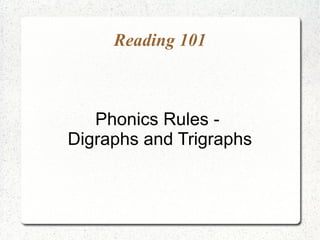
LL Lower Primary 1A - Digraphs and Trigraphs (o)
- 1. Reading 101 Phonics Rules - Digraphs and Trigraphs
- 2. Learning Objectives Master the rules governing the use of digraphs, trigraphs and quadgraphs in phonics. Pronounce accurately by being phonemically aware and phonetically knowledgeable.
- 3. Introduction • As you can recall, phonemes form the most basic sound in a word. • Some examples include: /b/ sound as in bonfire, black, bathtub, and balcony. /f/ sound as in fossil, fail, frame, and fingerprint. Short /a/ sound as in at, taxi, anniversary, laboratory, and tackle. Short /i/ sound as in it, gift, inflate and spinach
- 4. Digraphs and Trigraphs • Just as a flower with 3 petals is no more or less than a flower with 2 petals, a single sound can be produced by more than a single letter. • Digraph – 2-letter sound. For example, ph or /f/ sound – phone and phonics kn or /n/ sound – know and knife • Trigraph – 3-letter sound. For example, igh or /i/ sound – light and plight tch or /ch/ sound– match and catch
- 5. Digraphs and Trigraphs • In digraphs, consonants join together to form a kind of consonant team, which makes a special sound. • Similarly for trigraphs, consonants join together to form a consonant team as well. • In the earlier examples, /p/ and /h/ combine to form /ph/, which makes /f/ sound as in phone. • If you are unaware that /ph/ is /f/, you will read it as /p/ + /h/ combined, which is clearly wrong!
- 6. Consonant Blend • When two or more consonants appear together and you hear each sound that each consonant would normally make, the consonant team is called a consonant blend. • In other words, the resultant sound is the combined sound of each consonant.
- 7. More Consonant Blends • /fr/ as in frog, frock, friend • /fl/ as in fleece, flee, floss • /cl/ as in class, clock, click, clown • /cr/ as in crab, crass, crest, watercress • /gl/ as in glad, glass, glee, glow • /gr/ as in grass, grab, great, graph
- 8. Application • To improve your vocabulary, you need your knowledge of phoneme (letter sounds), phonics (sound rules) and whole language (reading texts). • Difficult words come naturally to you if you have heard them (whole language), know their parts and analyse them (phonemes and phonics) 1) charisma – /k/ + /air/ + /r/ + /e/ + /s/ + /m/ + /a/ 2) diaphragm - /d/ + /i/ + /er/ + /ph/ + /ragm/
- 9. Discussion • What do digraphs and trigraphs represent? • What are the use of digraphs and trigraphs in pronunciation? • When digraphs and trigraphs are read as each letter sound combined, what are they called?
- 10. Discussion (suggested answers) • What do digraphs and trigraphs represent? They represent 2-letter and 3-letter sounds. • What are the use of digraphs and trigraphs in pronunciation? They help us to identify the special or blended sound they produce. • When digraphs and trigraphs are read as each letter sound combined, what are they called? Consonant Blends
- 11. In Summary • We learn about phonemes as they help us in our spelling choice and reading. • Together with phonics (analyse sounds) and whole-language learning (reading texts), we become more proficient in spelling and reading. • Digraphs and Trigraphs introduce the idea of one sound represented by 2 and 3 letters respectively to help us read accurately when we see them.
